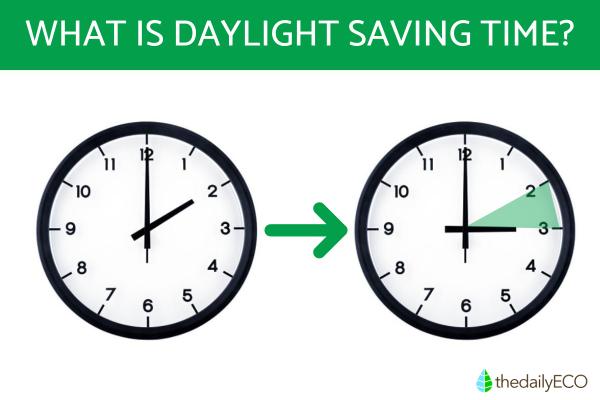Why Do Clocks Change Twice a Year?


Twice a year, many of us adjust our clocks, either springing forward or falling back. This peculiar tradition, known as Daylight Saving Time, has been around for over a century. The biannual ritual raises questions about its origins, purpose, and the impact it has on our lives.
The following article by thedailyECO explores why do we change the clock twice a year, highlighting its advantages and potential drawbacks.
Why do clocks change?
The practice of changing the clock time twice a year is directly related to Daylight Saving Time (DST). DST is typically implemented to make better use of natural daylight during different seasons. The clock changes associated with DST are as follows:
Spring forward
In the spring, usually on the second Sunday in March, at 2:00 AM local time, clocks are adjusted forward by one hour. This means that if it was 2:00 AM standard time, it becomes 3:00 AM DST. This shift extends daylight into the evening, helping to conserve energy and make better use of natural light during the longer days of spring and summer.
Fall back
In the fall, typically on the first Sunday in November, at 2:00 AM local time, clocks are reverted back by one hour. So, if it was 2:00 AM DST, it becomes 1:00 AM standard time. This adjustment returns the clock to standard time, ensuring that there is more daylight in the morning during the shorter days of autumn and winter.
The biannual clock changes associated with DST aim to synchronize our daily activities with the varying patterns of natural light throughout the year, helping to reduce energy consumption and make the most of available daylight.
This practice is widely used in regions where DST is observed. However, not all countries or regions around the world follow DST, so the clock changes are not universal.
When do clocks change?
The specific dates when clocks change, transitioning between Daylight Saving Time (DST) and standard time, vary by region and country. Let's examine some of the variations in these time transitions:
- Australia: clocks spring forward on the first Sunday in October at 2:00 AM Australian Eastern Standard Time (AEST) and fall back on the first Sunday in April at 2:00 AM AEST.
- Brazil: clocks spring forward on the third Sunday in October at 0:00 AM Brasília Time (BRT) and fall back on the third Sunday in February at 0:00 AM BRT.
- Canada: clocks spring forward on the second Sunday in March at 2:00 AM Eastern Standard Time (EST) and fall back on the first Sunday in November at 2:00 AM EST.
- China: clocks do not change.
- European Union: clocks spring forward on the last Sunday in March at 1:00 AM Central European Summer Time (CEST) and fall back on the last Sunday in October at 1:00 AM CEST.
- India: clocks spring forward on the second Sunday of October at 2:30 AM Indian Standard Time (IST) and fall back on the second Sunday of March at 2:30 AM IST.
- Mexico: clocks spring forward on the second Sunday in March at 2:00 AM Central Standard Time (CST) and fall back on the first Sunday in November at 2:00 AM CST.
- New Zealand: clocks spring forward on the second Sunday of September at 3:00 AM New Zealand Standard Time (NZST) and fall back on the first Sunday of April at 2:00 AM NZST.
- Russia: clocks spring forward on the last Sunday of March at 2:00 AM Moscow Time (MSK) and fall back on the last Sunday of October at 3:00 AM MSK.
- United Kingdom: clocks spring forward on the last Sunday in March at 1:00 AM British Summer Time (BST) and fall back on the last Sunday in October at 1:00 AM GMT.
- United States: clocks spring forward on the second Sunday in March at 2:00 AM Eastern Daylight Time (EDT) and fall back on the first Sunday in November at 2:00 AM Eastern Standard Time (EST).
Please note that the dates and times of clock changes may vary slightly from year to year, so it is always best to consult your local government website for the most up-to-date information.
Ever wondered why the moon shines in the darkness? Explore the scientific explanation for this phenomenon in our other article.
Benefits of changing the clocks
Daylight Saving Time is implemented in many countries to achieve a variety of benefits, including energy conservation, improved safety, economic stimulation, and positive impacts on public health. By making better use of available daylight, DST aims to address these multifaceted societal and environmental objectives, such as:
- Reducing artificial lighting: one of the primary motivations for implementing DST is to reduce the reliance on artificial lighting. By shifting the clocks forward in the spring, people have more daylight during the evening hours. This means less need for electric lighting, which can lead to significant energy savings. Less energy consumption, in turn, can contribute to reducing greenhouse gas emissions and the overall environmental impact.
- Reducing traffic accidents: longer daylight hours in the evening can enhance road safety. The increased visibility during the evening commute can lead to a reduction in traffic accidents. This is especially crucial during the months when DST is in effect.
- Reducing crime: extended daylight hours in the evening can also have a positive impact on public safety. It can deter criminal activities by making neighborhoods and public spaces better lit and more secure.
- Encouraging consumer spending: businesses often benefit from DST due to extended daylight hours in the evening. People are more inclined to engage in outdoor activities, shop, and dine out later into the evening. This increased consumer activity can provide a boost to the economy, particularly in industries that rely on consumer spending.
- Promoting tourism: DST can also stimulate tourism, as tourists have more time to explore and enjoy outdoor attractions during their visits.
- Increased physical activity: DST can lead to greater physical activity, as people are more likely to engage in outdoor recreational activities when there is more daylight after work and school hours. This can have a positive impact on public health by promoting exercise and a more active lifestyle.
- Enhanced mental health: more daylight hours in the evening can also improve mental health by reducing the likelihood of Seasonal Affective Disorder (SAD) during the darker winter months. Exposure to natural light and outdoor activities can elevate mood and well-being.
It is important to note that DST is not observed by all countries. For example, China, Japan, and most tropical countries do not observe DST.
After learning about the history and purpose of daylight saving time, discover the science behind the sun's yellow hue.
Drawbacks to changing the clocks
There are a number of drawbacks to changing the clocks twice a year. Here are some of the most common concerns:
- Sleep deprivation: one of the most commonly reported drawbacks of DST is sleep disruption. When clocks are set forward in the spring, people effectively lose an hour of sleep. This sudden shift in the daily schedule can lead to sleep deprivation, which, in turn, can result in fatigue, reduced alertness, and difficulties in concentration. It may take several days for individuals to fully adjust to the new time, and this sleep deficit can impact overall well-being.
- Circadian rhythm disruption: DST can also disrupt individuals' circadian rhythms, which are the body's internal biological clocks that regulate various physiological processes, including sleep-wake cycles. The abrupt time change can lead to a misalignment between the external time (clock time) and the body's internal time, which can further contribute to sleep disturbances and overall discomfort.
- Increased risk of heart attacks and strokes: some studies have suggested a potential link between DST and an increased risk of heart attacks and strokes in the days following the time change. The disruption of sleep patterns and circadian rhythms can place added stress on the cardiovascular system. It's worth noting that research in this area is ongoing, and not all studies have found a significant association.
- Sleep schedule disruption: children and adolescents are often more sensitive to changes in their daily routines, including sleep schedules. DST can be particularly disruptive to their sleep patterns, as it alters the time they wake up and go to bed. This disruption can lead to difficulties in falling asleep, waking up, and staying alert during the day.
- Problems with attention and behavior: the sleep disruption caused by DST can affect children's and adolescents' attention, mood, and behavior. This can be especially concerning for students, as it may lead to difficulties in focusing in school, irritability, and changes in behavior.
It's important to acknowledge that the impact of DST drawbacks can vary from person to person. While some individuals may adapt to the time change with little difficulty, others may experience more pronounced effects.
As a result, debates regarding the continuation of DST often involve discussions about the trade-offs between potential benefits and the drawbacks it poses to individuals' health and well-being.
Having learned about the history of daylight saving time, delve into the science of gravity and how it keeps the Earth orbiting the Sun.
If you want to read similar articles to Why Do Clocks Change Twice a Year?, we recommend you visit our Energy saving category.





